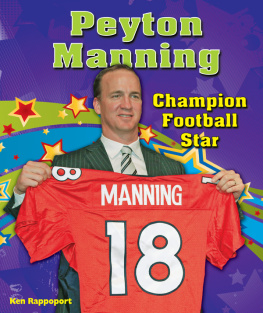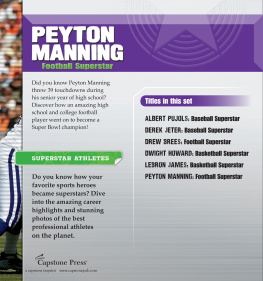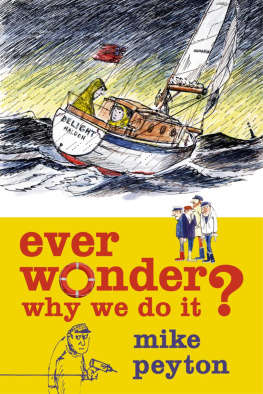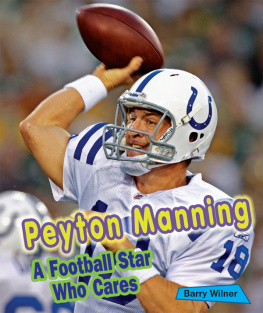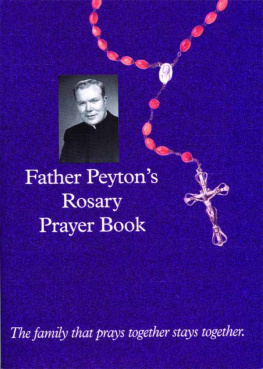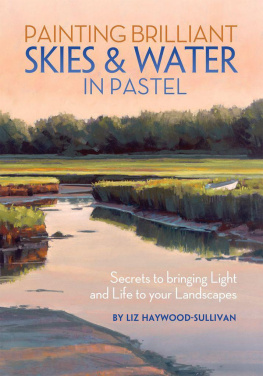Clear Skies, Deep Water
Clear Skies, Deep Water
A Chautauqua Memoir
BETH PEYTON
Cover photo courtesy of Beth Peyton
Published by State University of New York Press, Albany
2014 State University of New York
All rights reserved
Printed in the United States of America
No part of this book may be used or reproduced in any manner whatsoever without written permission. No part of this book may be stored in a retrieval system or transmitted in any form or by any means including electronic, electrostatic, magnetic tape, mechanical, photocopying, recording, or otherwise without the prior permission in writing of the publisher.
Excelsior Editions is an imprint of State University of New York Press
For information, contact State University of New York Press, Albany, NY
www.sunypress.edu
Production by Diane Ganeles
Marketing by Kate McDonnell
Library of Congress Cataloging-in-Publication Data
Peyton, Beth, 1956
Clear skies, deep water : a Chautauqua memoir / Beth Peyton.
pages cm (Excelsior editions)
ISBN 978-1-4384-5172-5 (pbk. : alk. paper)
1. Peyton, Beth, 1956 2. Peyton, Beth, 1956-Homes and hauntsNew YorkChautauqua Lake Region. 3. Chautauqua Lake Region (N.Y.)Social life and customs. 4. Chautauqua Lake Region (N.Y.)Biography. I. Title.
F127.C7P49 2014
974.7'95dc23
2013025551
10 9 8 7 6 5 4 3 2 1
For those weve lost, and all weve found
Contents
Acknowledgments
Thank you to all of the wonderful family, friends, and neighbors who have been with mewith usalong this journey, through thick and thin. Those included in the book were chosen because they supported the narrative, not because of their importance in my life then, or now. Thank you for sharing your memories, your photographs, your stories, and for letting us in.
I am truly indebted to the faculty, staff, guest writers, and my chums from Carlow Universitys low-residency M.F.A. program. Under the firm guidance of Director Ellie Wymard, PhD, I was blessed to study with both Irish and American writers. The Carlow community was beside me as I walked a pretty dark path, always pulling me toward beauty. They are beside me still. I am grateful for the ringing language of the Irish, and for that glorious sky that helped me see my own sky more clearly. Thank you for helping me persevere.
Jane Candia Coleman, my manuscript mentor and dear friend, helped me find my voice. In writing for her, I learned how to write for myself.
Thank you to Kathy Cherry, artist extraordinaire, who captured my story and the spirit of the lake in her wonderful maps.
I would be remiss if I did not acknowledge those involved with the literary arts at The Chautauqua Institution. Their celebration and support of reading and writing have helped me never forget the importance of books. The Institution is my center for lifelong learning, and just a quick boat ride away.
Thank you to Amanda Lanne, my Acquisitions Editor, Diane Ganeles, my Production Editor, Kate McDonnell, my Marketing Manager, and the rest of the staff at SUNY Press. I am truly grateful for their support, dedication, professionalism, and friendship. They made this process a blast.
Thank you most of all to my husband, Jeff Hunter, for being fully present and for having the courage and humor to live this life with me.
A version of Karaoke Night at the Casino appeared in The Jamestown Post-Journal January 28, 2012.
Prologue
I live on Chautauqua Lake. I love the way the word Chautauqua rolls off my tongue, the hard and soft sounds of it. Visitors describe the place as quaint, but I can feel a more ancient spirit here sometimesa spirit at least as old as the name Chautauqua itselfjust beneath the surface.
The dictionary defines Chautauqua as any outdoor summer meeting, but the movement that swept the nation around the turn of the nineteenth century, providing education combined with popular entertainment, lectures, concerts, and plays, started here, on Chautauqua Lake, in Western New York State. The name Chautauqua is derived from the Seneca language and most commonly is thought to mean a bag tied in the middle, or two moccasins fastened together. With its upper and lower basins cinched together between Bemus Point and Stow, on a map Chautauqua Lake does look like its tied in the middle. As with everything else here, there is more than one story, and as a result, both the meaning and derivation of the name have been debated. The word Chautauqua may actually be derived from the Cherokee, and may also mean the place where one was lost, foggy place, or the place where the fish was taken out. To me, Chautauqua is all these thingsand more.
Since the late 1800s, Chautauqua Lake has been a vacation destination point for the wealthy from New York City, Pittsburgh, Buffalo, and Cleveland. Located in the southwesternmost corner of New York State, the lake is large, over seventeen miles long, with a surface area of thirteen thousand acres. With an elevation over thirteen hundred feet, Chautauqua is one of the highest navigable waterways in the world. Even though it is in close proximity to Cleveland, Pittsburgh, and Buffalo, it has the feel and climate of a mountain lake, and is a good place to beat the summer heat.
On the map, the lake looks like a misplaced Finger Lake. Although it is not considered part of New York States Finger Lake system, it was formed by the same glacial mass as the Finger Lakes. They were carved when the glaciers came down, while Chautauqua was made when the glaciers retreated. The glacial activity left a wonderful layer of rich topsoil, in addition to a beautiful lake, and despite the cool climate and long winters, the vegetation and foliage are lush and green. The old-fashioned things look best here: hydrangeas, lilacs, roses, and rhododendrons. The cemeteries and the gardens in some of the old places contain tree hydrangeas, an heirloom variety with an upright habit, covered with heavy flower heads throughout the summer and fall. The blossoms weigh the trees down as they turn from white to pink, to rust, and finally, to the color of linen. The dried flowers provide winter interest in dining rooms, on porches, and in dormant gardens. Irises bloom in perennial gardens and grow wild along the creek beds, and in the spring, the roadsides are covered with white, pink, and purple phlox. Gladiolas burst forth in fields in late July. Buckets filled with cut glads ring the lake and grace porches until Labor Day, a sign of welcome.
Locally grown fruits and vegetables are sold at stands all summer long and into the fall. Regular truck garden producetomatoes, onions, squash, melons, corn, and beansis abundant. Peaches, apples, blueberries, strawberries, and even figs are available, although the fig trees must winter under shelter. The area is famous for its grapes. Concord grapes and little champagne grapes are the most common, and many growers in the area supply grapes for Welchs, which has a plant in Westfield, just over a big hill from Chautauqua on Lake Erie. Local wineries are beginning to experiment with vinifera grapes but have a long way to go to catch up with wineries in the Finger Lakes that are producing truly exceptional wines, both white and red.






